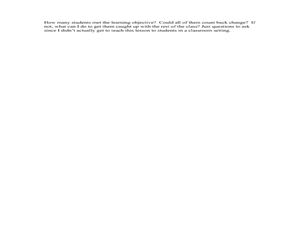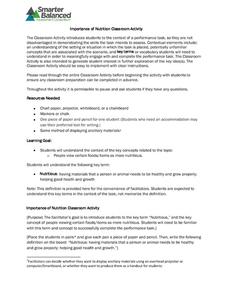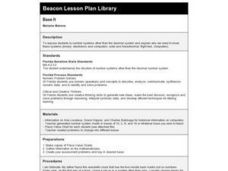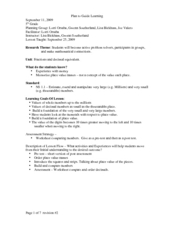Charleston School District
Review Unit 7: Real Numbers
Provide pupils with problems to check their understanding of the concepts within the unit. The seven-part series of lessons covers concepts related to irrational numbers. Learners convert between fractions and decimals, estimate the...
Virginia Department of Education
Powers of Ten
Investigate negative exponents of-ten. Pupils use the pattern of increasing powers of 10 to determine negative powers of 10. The scholars write the powers in expanded and product forms and make the connection to exponents using a...
Curated OER
All About Money
Few topics engage young mathematicians as much as learning about money. Through a series of shared readings and hands-on activities, children explore the US currency system, learning how to count money and calculate change as they create...
Council for Economic Education
Satisfaction Please! (Part 2)
Simply understanding consumer rights may not help people solve their problems. Understanding who to turn to becomes key in many different scenarios. Teach the value of various organizations that fight for consumer rights through...
Curated OER
Do You Value That Digit?
Sixth graders explore the term digit using large number and comma cards as they create numbers. In this digit value instructional activity, 6th graders identify the value of digits in large numbers and receive additional practice...
Curated OER
Money Game
Fourth graders give change of one dollar. In this decimal and fractions lesson, 4th graders receive fake coins and discuss what they could purchase with them. Students go for a walk and spend one dollar and get...
Charleston School District
Pre-Test Unit 8: Geometry Applications
What does a squared and b squared make? C squared of course! The pre-test assesses eighth graders' knowledge of the Pythagorean Theorem, application of the Pythagorean Theorem, and finding volumes of solids.
Curated OER
“Everyone Else Does It!” Ethics Project
Do you have good ethics? How about good morals? Scholars investigate the role business ethics, morals, and values play in society. Through role play, group work, and readings, they uncover the basis behind the importance of being...
Council for the Curriculum, Examinations and Assessment
Health and the Whole Person
The first lesson of the unit introduces class members to the social, physical, emotional, cognitive, and spiritual constituent elements of health and the need for balance among these elements. Class members used the provided assessment...
Virginia Department of Education
Functions 2
Demonstrate linear and quadratic functions through contextual modeling. Young mathematicians explore both types of functions by analyzing their key features. They then relate these key features to the contextual relationship the function...
Smarter Balanced
Importance of Nutrition
Prepare your class members for the performance task assessment on nutrition with an activity that asks class members to rank images of foods from least nutritious to most. Participants also offer reasons for why they ranked the...
Code.org
Looping and Random Numbers
Repetition, repetition, repetition. Get your class to efficiently repeat a section of code over and over again by introducing looping. Class members learn looping to quickly recreate objects they want to appear more than once in their...
John F. Kennedy Presidential Library & Museum
Red States/Blue States: Mapping the Presidential Election
Young historians investigate how voting patterns have changed by comparing the outcome of the 1960 election to the outcome of the recent election. A creative final assessment has participants making a news show wherein they provide...
Illustrative Mathematics
Regrouping
What number does 6 tens and 16 ones represent? How is it different from or similar to the number that 7 tens and 6 ones represent? This is the type of questions learners are asked to solve as a way to understand the concept of regrouping.
Curated OER
Expanded Form (E)
Put the power of place value in the hands of your eager learners. They assess 12 four-digit numbers and write each in its expanded form.
Curated OER
Expanded Form (P)
Now here is a challenge that can be used toward the end of the second grade. Learners will assess 12 five-digit numbers and write each in expanded form. A great way to reinforce place value and build number sense.
Curated OER
Base It
Third graders complete place value charts in the decimal system, the binary and Hexadecimal system. They discuss the contributions made by Ada Lovelace to computer language. They express the idea of place value with exponents.
Curated OER
Fractions and Decimal Equivalents: Fifth Grade
Sometimes a skeleton is all you get. This lesson outline provides teachers with a basic lesson flow. Pupils will pre-test, order place value names, use manipulatives, and build and compare numbers. How this is to be done is not...
Concord Consortium
Calculator Numbers
Know thy calculator. Young mathematicians use their calculators to answer a set of questions. They consider how the number of digits the calculator displays affects the answers to calculations. They then find examples of computations...
Curated OER
Putting Pitch In Its Place
Young scholars focus on reading musical notations. They see, hear, practice and write notations in the lessons to become more independent readers of music. They complete a Rubric for Pitch Worksheet.
Balanced Assessment
Fractured Subtraction
Can you spare a 10? Scholars determine digits that could complete a two-digit subtraction problem. They must find all possible combinations of digits and provide an explanation for their reasoning.
Illustrative Mathematics
How Many Tenths and Hundredths?
Four hundredths + one tenth = 14 hundredths. Learners complete place order equations in order to make each equation true. Hundredth and tenths are the focus of the worksheet.
Curated OER
Coin Carnival
Young scholars investigate the value of coins. In this coin value lesson, students read The Penny Pot by Stuart Murphy. Young scholars expand on skills learned in the book and engage in activities to determine the value of a mixed set of...
Curated OER
Money Math Carnival
Third graders explore money in a carnival format. For this money lesson, 3rd graders create a carnival of mathematics activities. Students determine the value of money in mixed amounts and explore how to create representations of money.

























